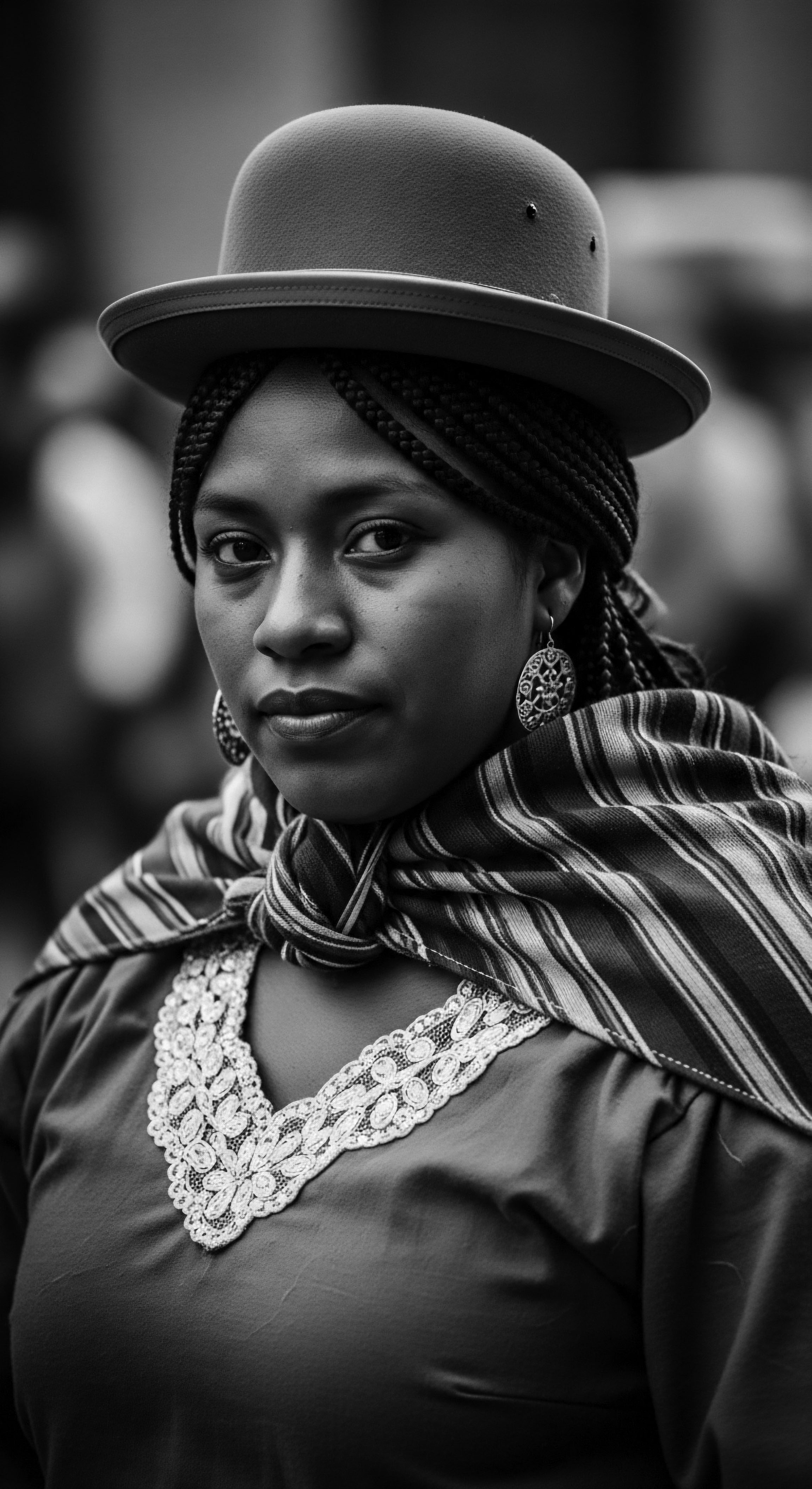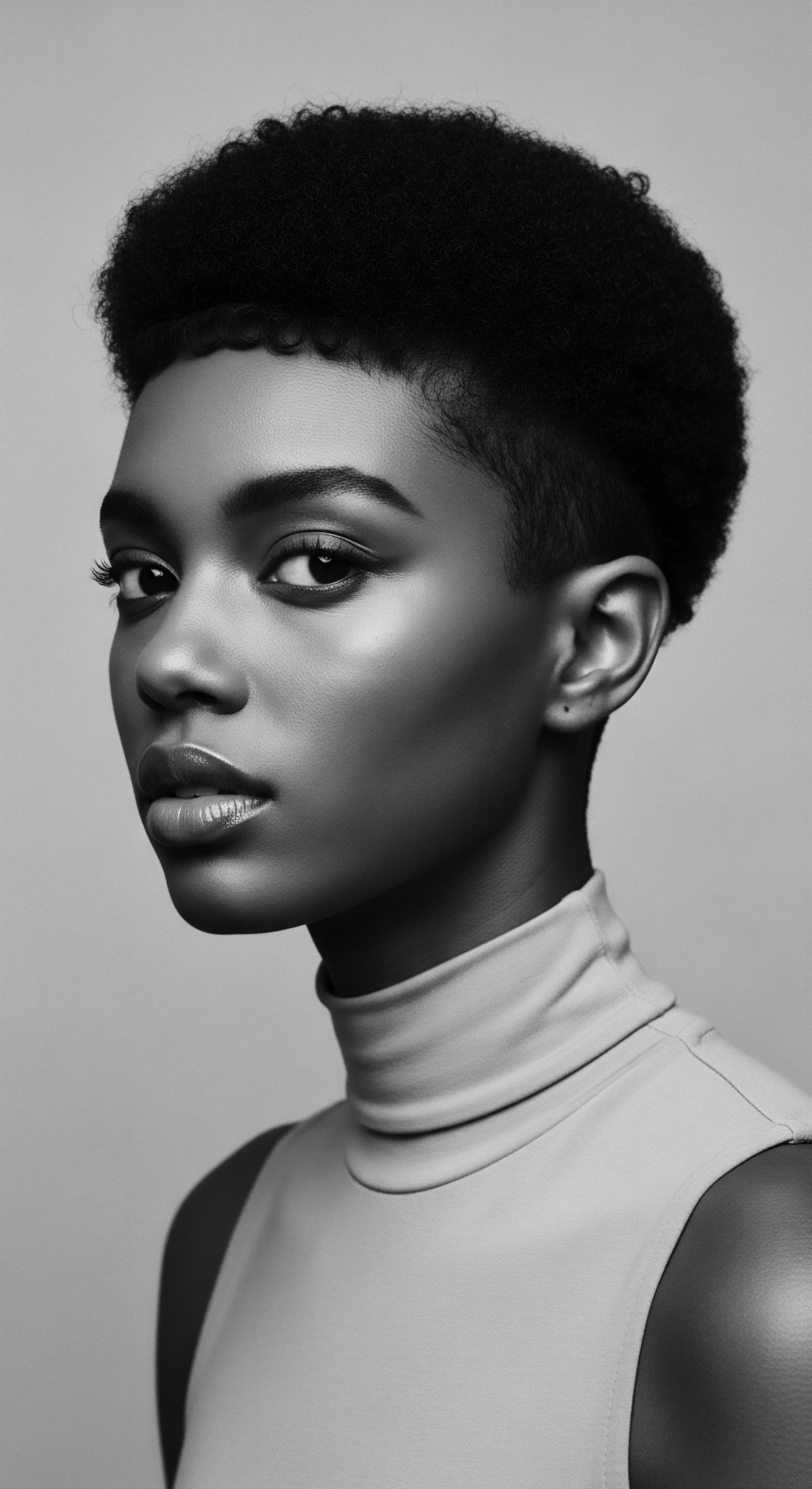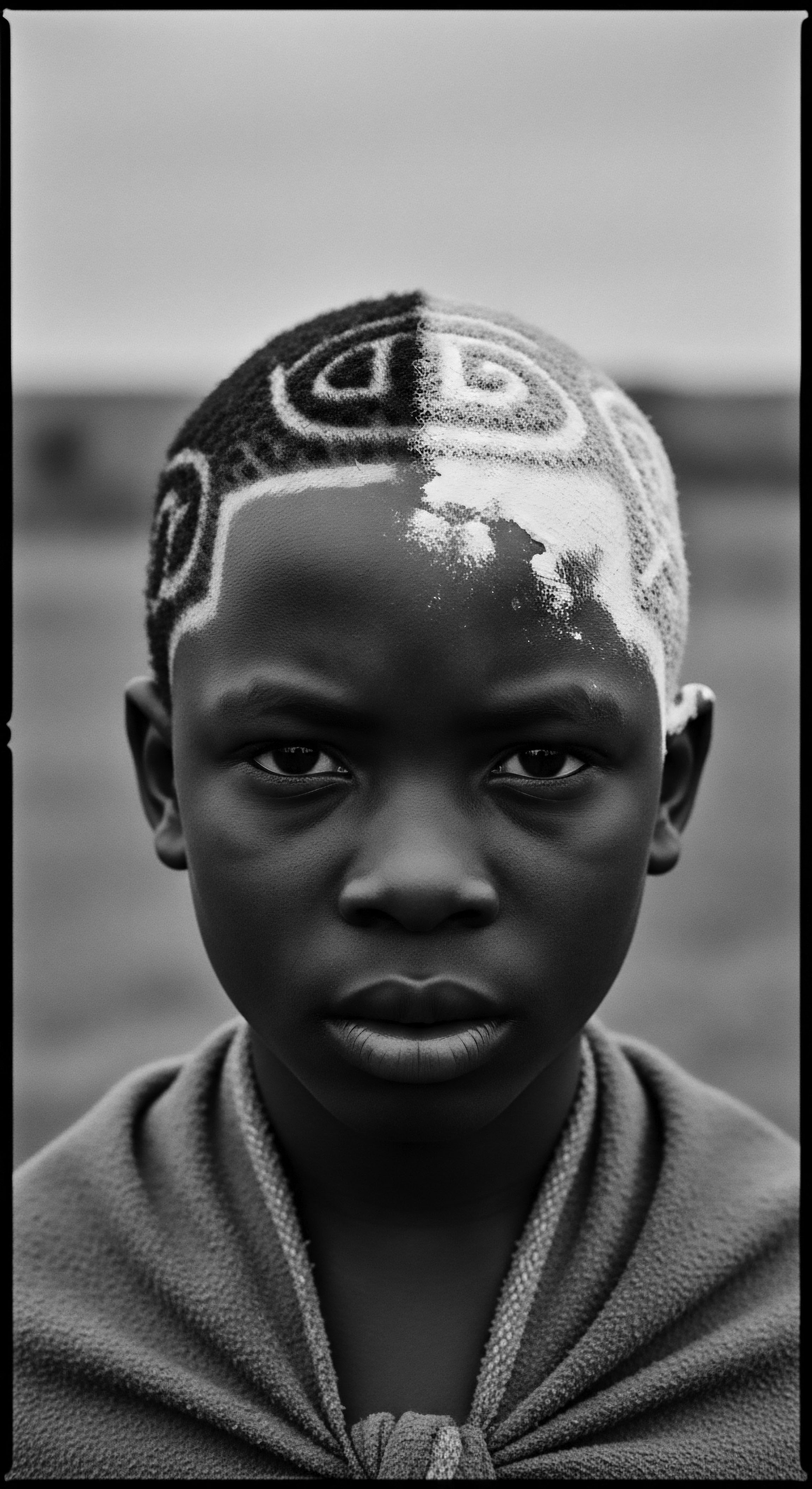
Roots
The story of textured hair is an ancestral echo, a profound narrative etched into the very strands that adorn millions across the globe. For those who carry the legacy of coiled, kinky, and wavy hair, its care is rarely a mere beauty routine; it is a communion with generations past, a silent dialogue with history. It represents a heritage of resilience, ingenuity, and deeply rooted practices that connect us to the earth and the wisdom of those who walked before.
Within this expansive story, the radiant essence of argan oil stands as a golden thread, a testament to ancient techniques passed down through time. Its liquid luminosity, hailing from the sun-drenched landscapes of Morocco, offers a potent link to an ancient botanical tradition, a heritage of nurturing hair in challenging environments.
Consider the argan tree , Argania spinosa (L.) Skeels, indigenous to the arid southwestern regions of Morocco, primarily within the provinces of Agadir, Taroudant, Essaouira, and Tiznit. This tenacious tree, with its deep, extensive root system, functions as an irreplaceable ecological barrier against desertification, a shelter for thousands of species. Its unique role in environmental sustainability and the livelihoods of the indigenous Amazigh people, often called the Berbers , has been recognized globally.
In 2014, practices and know-how concerning the argan tree received inscription on the UNESCO Representative List of the Intangible Cultural Heritage of Humanity, solidifying its standing as a natural and cultural treasure. For centuries, argan oil, extracted from its fruits, has played a unique role in the diet, rituals, and personal care of the Berbers.
The journey of argan oil is a whispered legend, connecting textured hair care to the ingenious traditions of North Africa.

What is the Elemental Biology of Textured Hair and Argan Oil?
Textured hair, particularly that with tighter curls and coils, possesses a unique elliptical or flat cross-section, differing significantly from the more circular cross-section of straight hair. This structural distinction influences how oils and moisture travel along the hair shaft. The natural bends and twists in textured strands create more opportunities for moisture to escape and for the cuticle—the outermost layer of the hair—to lift, leaving the inner cortex vulnerable. This inherent characteristic makes textured hair more prone to dryness and breakage, thereby emphasizing the historical need for enriching emollients and protective practices.
Argan oil, often celebrated as ‘liquid gold,’ owes its remarkable efficacy to its particular chemical composition. It is rich in essential fatty acids , including oleic acid and linoleic acid, which comprise a significant portion of its structure. These fatty acids are crucial for lubricating the hair shaft and assisting the hair in retaining moisture. Beyond these, argan oil is teeming with antioxidants and Vitamin E , powerful components that offer protective qualities.
These properties help guard hair against environmental damage, oxidative stress, and the wear of daily styling. Scientific investigation reveals that argan oil may enhance cell growth in hair follicles while preventing inflammation. This interplay of nourishing fats and shielding antioxidants aligns seamlessly with the historical understanding of plant-based remedies for maintaining hair health in often harsh climates.
The traditional method of extracting argan oil, a labor-intensive process, has remained consistent across generations. Berber women meticulously gather the fruit, dry it under the sun, and then manually crack the nuts to extract the precious kernels. These kernels are then ground or pressed, often by hand, to release the golden oil. This ancestral method, passed down from generation to generation, is not only a means of livelihood but a true demonstration of care and patience, a living tradition of natural self-care.
- Oleic Acid ❉ A monounsaturated fatty acid, plentiful in argan oil, known for its ability to soften and smooth hair strands, assisting in moisture retention.
- Linoleic Acid ❉ An omega-6 fatty acid that aids in reinforcing the hair’s natural barrier, protecting it from moisture loss and external aggressors.
- Vitamin E (Tocopherols) ❉ A potent antioxidant that helps defend hair and scalp cells from free radical damage, supporting a healthy environment for growth.

Ritual
The ritual of textured hair care, deeply informed by ancestral practices, extends far beyond mere application; it is a holistic engagement that connects the individual to community, spirit, and the rhythms of nature. Before the advent of modern commercial products, African and diasporic communities devised intricate systems of care, relying on the land’s provisions and a profound understanding of hair’s inherent needs. Argan oil’s journey into these practices, particularly among North African communities, exemplifies this ancestral ingenuity. The historical context reveals how oils were not simply conditioners but integral components of elaborate styling, protection, and social expression.
For centuries, hair in African societies served as a reflection of personal identity, social status, and stages in life. Hairstyles could convey age, marital status, wealth, or even political views. The process of styling often took hours or even days, serving as a time of bonding and community among women.
This intricate styling process often included washing, combing, oiling, braiding or twisting, and decorating the hair with materials such as cloth, beads, or shells. Argan oil, alongside other natural oils like shea butter and coconut oil, was a cornerstone of these traditional practices, valued for its moisturizing and protective properties.
The historical art of styling textured hair demonstrates a profound understanding of natural ingredients for protection and adornment.

How Did Ancient Protective Styling Integrate Argan Oil?
Protective styling is a venerable tradition across diverse textured hair communities, a testament to ancestral knowledge geared towards minimizing manipulation and shielding delicate strands from environmental exposure. Styles like Braids, Twists, and Cornrows, worn for both practical and symbolic reasons, found their efficacy greatly enhanced by the thoughtful application of nourishing oils. Argan oil, with its fatty acids and conditioning properties, would have been worked into the hair before, during, and after these styles were created. This application would serve several purposes ❉ softening the hair to make it more pliable for intricate braiding, sealing in moisture to prevent dryness and breakage over extended wear, and providing a lustrous finish that also conferred a layer of environmental defense.
The Berber women of Morocco, for instance, have traditionally used argan oil as part of their daily beauty and wellness rituals, applying it to both skin and hair. This practice reflects a deep understanding of the oil’s capacity to hydrate and fortify hair, particularly valuable in the dry, often arid climates where textured hair can be especially susceptible to moisture loss. Beyond its practical benefits, the act of oiling the hair was often imbued with ritualistic significance, a tender gesture of care that connected individuals to their cultural heritage. The preparation and application were communal activities, fostering bonds and passing down intergenerational wisdom.
The use of argan oil in ancient hair practices also extended to preparing the hair for various adornments. Hair, viewed as a conduit for spiritual energy and a symbol of one’s connection to ancestors, was often decorated with shells, beads, and other natural elements. A well-oiled and conditioned base, achieved with substances like argan oil, would have made the hair more receptive to these additions, ensuring they held securely and contributed to the overall aesthetic without causing undue stress to the hair shaft. This underscores the interplay between care, styling, and cultural expression—a profound interplay where argan oil played a quiet yet consistent role.
| Practice Category Protective Styling |
| Ancient Techniques for Textured Hair Braids, twists, cornrows, locs often worn for extended periods to preserve hair and minimize manipulation. |
| Connection to Argan Oil's Legacy Argan oil softened hair for braiding, sealed moisture within protective styles, and provided a protective barrier against harsh elements. |
| Practice Category Pre-Wash Oiling |
| Ancient Techniques for Textured Hair Saturating hair and scalp with oils before cleansing to reduce stripping and add deep conditioning. |
| Connection to Argan Oil's Legacy Argan oil used as a pre-wash treatment, massaged into scalp and strands, allowed for deeper penetration and nutrient delivery. |
| Practice Category Scalp Invigoration |
| Ancient Techniques for Textured Hair Massaging the scalp with oils to stimulate circulation and support healthy hair growth. |
| Connection to Argan Oil's Legacy The antioxidants and fatty acids in argan oil nourished the scalp, creating a healthy environment for follicles, a practice passed down through generations. |
| Practice Category These ancestral applications of argan oil demonstrate its long-standing importance in maintaining the integrity and beauty of textured hair within cultural traditions. |

Relay
The enduring legacy of ancient techniques for textured hair care, particularly those involving argan oil, persists through generations, relayed not merely as practices but as living embodiments of cultural identity and wisdom. This transmission transcends simple instruction; it is a deep-seated cultural exchange, often taking place within the intimate spheres of family and community. The efficacy of argan oil, once understood through empirical wisdom, now finds resonance in contemporary scientific insights, bridging the gap between ancestral knowledge and modern understanding. Its journey from a local Moroccan treasure to a globally recognized elixir speaks volumes about the universality of its benefits and the power of heritage-driven solutions.
The traditional knowledge surrounding the argan tree and its oil, particularly its production by women, has been a cornerstone of Berber and Arab-origin indigenous rural communities for centuries. This knowledge, shared through non-formal education, emphasizes the communal and intergenerational aspects of argan oil’s legacy. The process of producing argan oil often served as a social activity, strengthening community bonds among women. This collective wisdom informs the holistic approach to hair care that has been characteristic of many African and diasporic traditions, where hair health is viewed as an extension of overall well-being.
The journey of argan oil from ancestral Moroccan hands to global recognition exemplifies a profound cultural relay.

What is the Scientific Validation of Argan Oil’s Ancestral Uses?
Modern scientific exploration offers compelling validation for the long-held ancestral applications of argan oil in textured hair care. The richness of argan oil in Vitamin E and various fatty acids is not merely anecdotal; these components are scientifically recognized for their conditioning, moisturizing, and protective properties. Oleic and linoleic acids, prevalent in argan oil, are known to lubricate the hair shaft, assisting in moisture retention, a critical need for textured hair, which is inherently prone to dryness.
Research indicates that argan oil provides a protective layer to the hair, which can improve combing force and reduce breakage during styling. This is particularly relevant for textured hair, which can be vulnerable to mechanical stress. A systematic review published in 2022, while noting limited evidence specifically for hair growth, highlighted that argan oil can improve hair quality and protect it from damage. A study involving different concentrations of argan oil on mice showed increased hair growth, with higher concentrations yielding more growth.
This aligns with historical claims of argan oil’s role in promoting hair vitality. Furthermore, argan oil’s anti-inflammatory and antioxidant properties are well-documented, benefiting scalp health by potentially mitigating conditions like psoriasis or seborrheic dermatitis, which can influence hair loss. This scientific understanding grounds ancestral practices in a contemporary framework, affirming the wisdom of past generations.
- Vitamin E ❉ Acts as a powerful antioxidant, protecting hair and scalp from oxidative stress, often caused by environmental factors.
- Essential Fatty Acids ❉ Primarily oleic and linoleic acids, which moisturize, condition, and strengthen the hair fiber, reducing susceptibility to breakage.
- Polyphenols ❉ Compounds within argan oil that contribute to its anti-inflammatory and antioxidant activities, supporting overall scalp health.
The connection between nutrition and hair health, a principle well-understood in ancient wellness philosophies, also finds scientific backing. Diets rich in essential nutrients, including proteins, vitamins (especially B vitamins, A, C, E), and minerals like zinc and iron, directly influence hair growth and structural integrity. Ancestral diets, often composed of whole, unprocessed foods, naturally provided these vital elements. For example, traditional North African diets would have provided a spectrum of nutrients that complemented external hair care rituals, contributing to the overall health of the scalp and strands.

How do Environmental Elements Influence Traditional Practices?
The environment in which textured hair heritage evolved deeply influenced the techniques and ingredients employed for its care. In arid and semi-arid regions, such as those where the argan tree flourishes, preserving moisture and protecting against harsh sun and wind were paramount concerns. Traditional practices reflect this ecological imperative.
Argan oil, with its deeply moisturizing and protective qualities, emerged as a logical and effective solution. Its use was not arbitrary; it was a direct response to the climatic conditions that could otherwise render hair dry, brittle, and vulnerable.
Consider the Himba tribe in Namibia, who traditionally use a mixture of red ochre (clay) and butter, often infused with aromatic resins, to coat their hair and skin. This practice, known as ‘otjize’, provides not only a distinctive aesthetic but also a practical defense against the intense sun and dry winds of their environment. While this differs from argan oil in specific ingredients, the underlying principle of using natural emollients and protective coverings to shield textured hair from environmental stressors remains consistent across various African traditions. The availability of resources shaped the specific expressions of care, yet the intent remained universal ❉ to fortify and preserve hair.

Reflection
The journey through ancient techniques for textured hair care, interwoven with the legacy of argan oil, is a profound meditation on heritage. It is a chronicle of ingenuity, resilience, and a deeply felt connection to the earth and its offerings. From the painstaking manual extraction by Berber women, a tradition stretching back centuries, to its contemporary presence in global hair regimens, argan oil has traversed landscapes and eras, carrying with it the soul of a strand—the very essence of textured hair heritage. This liquid gold, born of the tenacious argan tree, serves as a tangible link to ancestral wisdom, demonstrating how practices rooted in the past continue to offer profound guidance for holistic well-being today.
The rich narrative of textured hair, particularly for Black and mixed-race communities, is a living archive. It is a story told not only through intricate styles and communal rituals but also through the very ingredients chosen to nourish and protect. The continuity of argan oil’s use, from ancient North African hammams to modern self-care routines, underscores a powerful truth ❉ true innovation often lies in the rediscovery and honoring of foundational knowledge. Each drop of argan oil carries the echoes of hands that worked the kernels, of whispers of care exchanged through generations, and of a steadfast commitment to hair that reflects identity, strength, and beauty.

References
- Abouri, M. et al. (2012). Ethnobotanical survey of medicinal plants used in the treatment of dermatological diseases in the region of Fez, Morocco.
- Al Arabiya. (2016). Traditional beauty secrets of North African Berber women.
- Bejaoui, S. et al. (2021). Ethnobotany, phytochemistry and biological properties of Argan tree (Argania spinosa (L.) Skeels) (Sapotaceae) – A review. Journal of Ethnopharmacology.
- Diplomacy & Commerce. (2024). The Story About Argan – The Symbol of Resilience.
- Food and Agriculture Organization of the United Nations. (2021). The Moroccan landscape, traditions and communities behind argan and its oil.
- Healthline. (2019). Argan Oil for Hair Growth ❉ Overview, Benefits, Uses, and Efficacy.
- Healthline. (2022). Add These 8 Foods to Your Diet for Healthy Hair, Skin, and Nails.
- IJIH : ❉ Article. (n.d.). Liquid Gold ❉ Berber Women and the Argan Oil Co-operatives in Morocco.
- Jules Of The Earth. (n.d.). Baobab Oil ❉ Africa’s Ancient Beauty Secret for Radiant Skin and Hair.
- Karabacak, E. & Doğan, N. (2014). Hair loss and scalp diseases in children.
- KnE Medicine. (2022). Hair Growth Promotion of Argan Oil (Argania Spinosa Skeels) Nanoemulsion Hair Tonic Preparation With Mice (Mus Musculus).
- Livara Natural Organics. (2023). Black History Month ❉ The Rich History of Our African Hair.
- Oforiwa, A. (2023). The History and Culture of African Natural Hair ❉ From Ancient Times to Modern Trends. AMAKA Studio.
- Raw African. (2023). The Miracle Elixir for Hair, Skin, and Beauty.
- SciELO. (n.d.). Ethnobotany, traditional knowledge, and nutritional value of Argan (Argania spinosa (L.) Skeels) in Western Anti-Atlas of Morocco.
- Sellox Blog. (2021). Ancient African Hair Growth Secrets For Healthy Hair.
- The Independent Pharmacy. (n.d.). Protein Intake and Hair Loss ❉ Is There a Connection?
- The United Nations. (2025). International Day of Argania.
- University of Salford Students’ Union. (2024). The Remarkable History Behind Black Hairstyles.
- WebMD. (2024). Argan Oil ❉ Health Benefits, Nutrition, and Uses.
- Wimpole Clinic. (2024). Does Argan Oil Grow Hair? Here’s What The Research Says.
